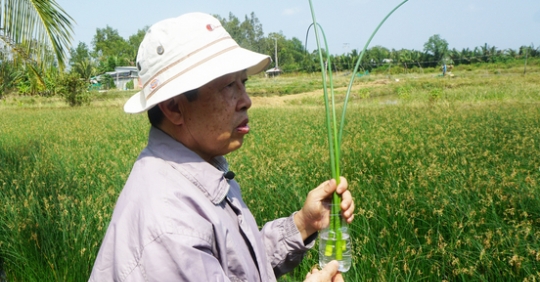Imaginative grass – the magical water purifier
In the Mekong Delta, in recent years people in the coastal areas have recognized the value of grass, which provides farmers with additional livelihood income. Among the numerous species of wild plants in the wetlands, it is a natural source of material suitable for a new production model in rural areas, along with sedge, water hyacinth and sedge. In addition, this is also a tree that adapts to climate change and maintains a sustainable ecological environment.
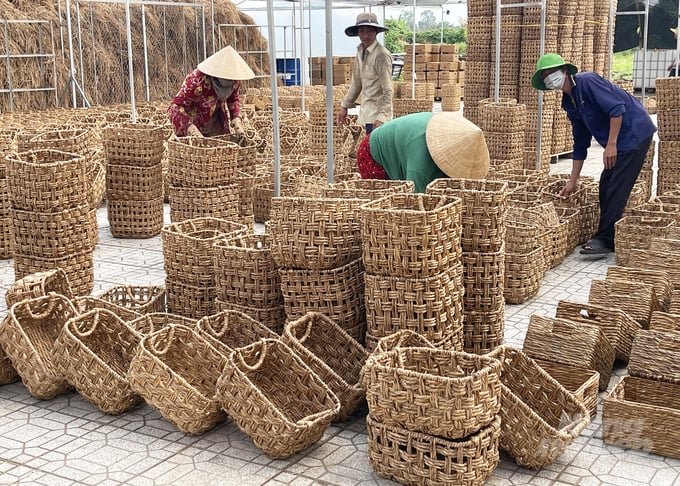
Knitwear made from dandelion grass for export. Picture: Hu Duc.
The scientific name is Scirpus littoralis Schrad, which grows naturally in the swamps in the coastal areas of the Mekong Delta. The grass has the ability to biologically filter, taking oxygen from nature and bringing it to the roots. It’s possible to do a simple little experiment in the field, as long as the sun is hot the grass will “self-power” to generate oxygen for the water with that pungent smell.
Some scientists and farmers have tested that in areas where natural grasses grow in the fields in Bac Lieu, Ca Mau, Kien Giang, etc., they have the ability to purify water sources and create a good environment for shrimp and crab. .. appropriately, according to people’s aquaculture model, especially suitable for the extensive rearing model or environmental improvement.
dr Duong Van Ni, former director of Can Tho University’s Center for Experimental Research – Hoa An (Hau Giang) Biodiversity, has spent many years researching wetland biodiversity in the Mekong Delta. Since 2006 he has seen and compared this grass species as a godsend, especially its adaptability to salty and brackish environmental zones.
At the end of February 2023, we visited the rice and shrimp cultivation area in Hoa Tu 1 Township, My Xuyen District, Soc Trang Province. The month of January is over, the day is hot and sunny. The new asphalt road from Tham Don leads to Hoa Tu 1 community, with many crab ponds basking in the sun on both sides of the road. The grass on the banks of the square with yellow shrimp exposed to the fight. However, sometimes there are still a few shrimp squares lined with water-filled canvas and fans are blown white.
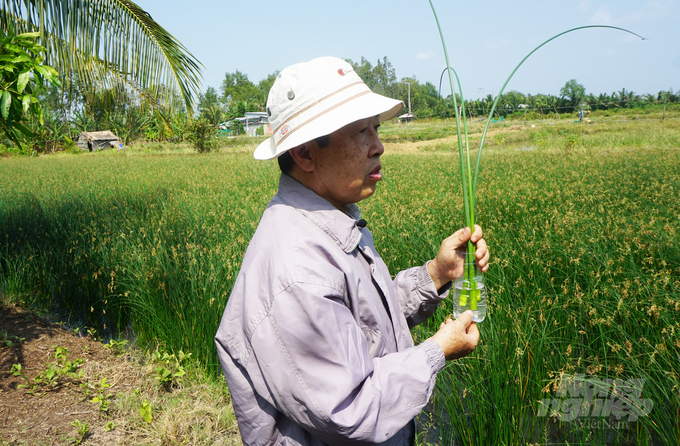
dr Duong Van Ni experimented with pumping oxygen into the water of plants. Picture: Hu Duc.
The community of Hoa Tu 1 in the hamlet of Hoa Tan is salty and brackish land lying deep in the field. Earlier this year, at the start of the dry season, the fields hung dry, waiting for the salt water to return. Many neighboring households have people making rice shrimp models, but Mr. Thien (Hong Minh Thanh) still fills the pond with water, turns on the fan and releases farmed shrimp. He said the salt water was not enough, about 1-2 minutes, it was almost like raising fresh water, some people were still waiting for the salt, but he just let go, just worried that the shrimp slowly grew.
In the salt-brackish area, although some localities have some irrigation systems, the search for a compatible production model to increase the value of agricultural products still seems to be involved due to the salt-fresh water dispute. Mr Thien said he thought about farming copperfish but now which fish is well consumed and how much profit can be made to decide on a sustainable move he still wonders…
dr Duong Van Ni wants to find and develop a solution to eliminate the salt-sweet conflict and increase sustainable income. In particular, reed grass – the grass that grows in abundance in Ca Mau has now been planted by farmers in Soc Trang. The grass is green, the field water is clear, the birds are jumping and chirping.
Both for high incomes and job creation
dr Duong Van Ni is currently the Chairman and Director of the MCF Foundation (Mekong Conservancy Foundation). MCF, together with the Women’s Union of My Xuyen District (Soc Trang), has been seeking community consensus to apply the model to improve the livelihood of the fig tree.
Ms. Tran Hong Ni, chairwoman of the My Xuyen District Women’s Association, was the pioneer when she made the tree plant 1 ha in her home field. Mr. Hai Mat (Tran Van Mat) – Ni’s father supports his daughter’s new farming model. Neighbors also called the statue Hai Mat, although some people at first suspected that this grass could not be destroyed beforehand, why bring it back anyway?
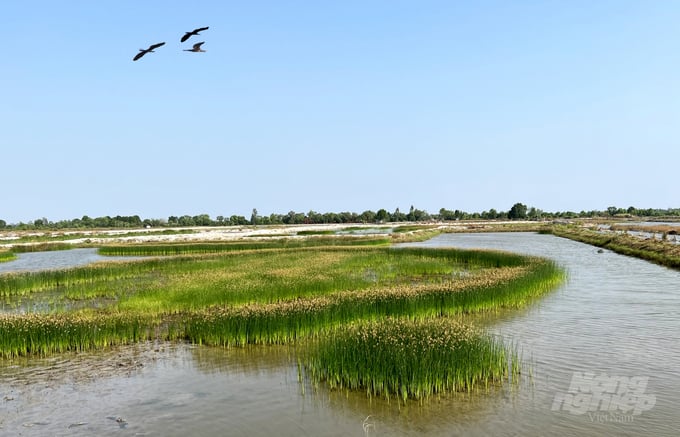
Natural grassland in shrimp fields on the Ca Mau Peninsula. Picture: HT.
Mr. Hai Mat said: After many years of restructuring production, rice and shrimp have been planted in the homeland. There have also been severe years waiting for the saltwater to rise late like earlier this year, making it difficult to release shrimp. The story is just beginning to get difficult, once the new crops and animals are planted risks may have to be taken. Bringing back the newly planted grass is another story.
This grass is easy to find, easy to grow, and well-adapted to saline or brackish wetlands. According to scientists, the grass tolerates a salt content of 8 ‰ like a tub tree, even with a salt content of 15-20 ‰ it does not die. Just transplant 3 thrifts into the muddy soil of the field, a distance of 7 – 8 inches (70 – 80 cm) in a short time, the tree will bloom by itself.
Compared to a previous rice harvest which costs manpower, plows, pesticides, etc., when the season is calculated, the profit is about 2-2.5 million VND/labour. While growing crops without using fertilizers and pesticides, all you have to do is keep the water so that they don’t overwhelm the grass tops, collect 2 tons of fresh / labor (1,000 m2) and dry to 1 ton. Each productive crop is harvested after 4 months, purchased by MCF Vietnam Joint Stock Company (supported and consulted by MCF Fund) and used as raw material for basket weaving (handicrafts) for export.
On average, 7-8 kg of fresh coriander are harvested after drying and 1 kg of dried coriander. The price of fresh figs is around 600-700 VND/kg, after drying 8,000-10,000 VND/kg (depending on the location far away or near the point of purchase). Average income is 6-8 million VND/work, sum of 3 installments is 18-24 million VND/work/year. In fact, farmers are much less labor intensive than growing rice. Not to mention the enormous environmental benefits thanks to the ability to purify water, algae, soil … from which shrimp, crabs or fish can be freed.
Currently, My Xuyen District Women’s Association has organized 27 cooperative knitting groups with 15-20 knitters/group. Raw materials from sorghum knit baskets supply about 700 products/week for MCF Company. Depending on the product model, the processing price for basket weaving ranges from 14,000 to 31,000 VND/basket. Each basket maker has a weekly income of 400 – 500,000 VND.
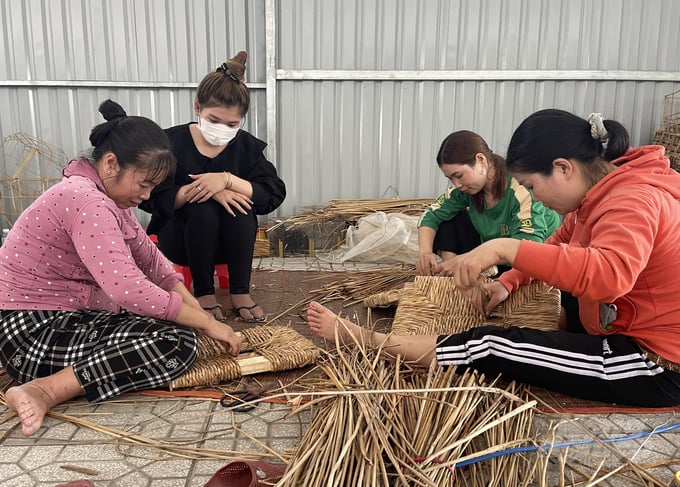
Rural women learn to weave baskets from dried fig grass at the MCF My Quoi Cooperative. Picture: Hu Duc.
In addition, My Quoi Cooperative, Nga Nam Town, was established at the end of 2021 with 9 members and currently forms a network of more than 400 rural workers in My Quoi and My Binh communities who knit. Through the municipality’s women’s union, the My Quoi cooperative continues to provide (free) knitting training, bringing the total to 700 outsourced workers.
In 2022, the cooperative provided 30,000 products. In 2023, the cooperative plans to process artisanal products from scratch and deliver 10,000 products/month. The cooperative collects raw materials from the cultivation area and delivers semi-finished products to the MCF coordination center. The MCF branch center in Soc Trang is the place where knitting products are collected from cooperatives and cooperative groups, and then finished products are packed to deliver 30,000 to 40,000 products monthly to Housewares Company (Binh Duong) for export. 100% export to USA. Australia, Japan.
According to a new source from the Ministry of Industry and Trade, weed is a new item for which some import-export companies in the South have found export markets to China. Dried figs are used as raw materials for making handicrafts such as bags, interior decorations, carpets, etc., with an average export price of 2,100-2,800 yuan/ton. There is a great demand for this material in Guangdong and Fujian.

